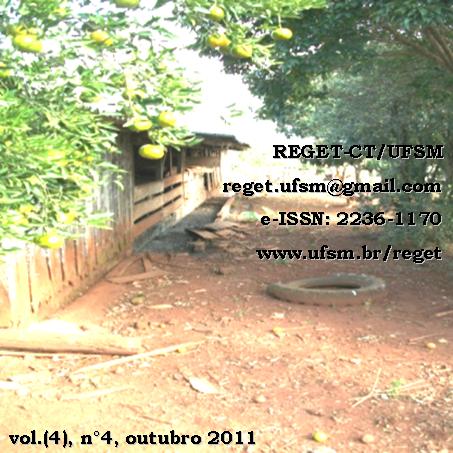PERCEPÇÃO DOS ATORES ENVOLVIDOS NO PROJETO GARABI-ITA SOB O OLHAR DA EDUCAÇÃO AMBIENTAL
DOI:
https://doi.org/10.5902/223611703895Palabras clave:
Recomposição, Mata Ciliar, Projeto, Percepção, Educação Ambiental.Resumen
http://dx.doi.org/10.5902/223611703895
O objetivo desta pesquisa foi investigar, sob o olhar da educação ambiental, a percepção dos atores envolvidos no Projeto Garabi-Itá sobre o mesmo e sobre a participação da Escola Municipal de Ensino Fundamental Bom Pastor, além de verificar os resultados da recomposição da mata ciliar do arroio do Moinho. Foi efetuada uma pesquisa de campo com observação das áreas de plantio de árvores, realizada uma visita e aplicado um questionário aos proprietários, professores e ex-monitores. O Projeto Garabi-Itá, nas propriedades em que a Escola auxiliou no plantio, foi considerado positivo por todos os atores envolvidos na pesquisa. Entre os fatores mais perceptíveis pelos proprietários, estão a menor erosão do solo, maior presença de pássaros, insetos, répteis e pequenos mamíferos. Todos consideraram satisfatória a participação dos monitores e destacaram a importância do papel da escola como motivadora na implantação de projetos na comunidade. É relevante o fato de muitos ex-monitores terem sido motivados a participar do Projeto por colegas, o que mostra a importância da formação de líderes dentro da Escola, como motivadores de ações de educação ambiental. Ficou evidente a compreensão de que deve haver um envolvimento coletivo para a resolução dos problemas do arroio do Moinho, em relação à melhora da qualidade da água e à restauração da mata ciliar. A pesquisa também mostrou que é necessário algum estímulo para a participação em projetos ambientais, pois 50% dos produtores, 75% dos professores e 60% dos ex-monitores participariam de forma espontânea, e o restante somente se fosse convidado, ou obrigado.
Descargas
Citas
BRASIL. Parâmetros Curriculares Nacionais, Ensino Fundamental. Disponível em:<http://www.portal.mec.gov.br/seb/arquivos/pdf/livro01.pdf > Acesso: em 10 mai. 2011.
BRASIL. Lei nº 9.795, de 27 de abril de 1999. Disponível em: http://www.planalto.gov.br/ccivil_03/leis/l9795.htm. Acesso
em: 20 mai. 2011.
CORNELL, JOSEPH. Vivências com a Natureza. São Paulo: Ed. Aquariana, 2005.
DIAS, GENEBALDO FREIRE. Educação Ambiental: princípios e práticas. 9. ed. São Paulo: Gaia, 2004.
GADOTTI, MOACIR. Educar para a sustentabilidade: uma contribuição à década da educação para o desenvolvimento sustentável. São Paulo: Editora e Livraria Instituto Paulo Freire, 2009.
LEGAN, LÚCIA. A escola sustentável – eco- alfabetizando pelo ambiente, 2. ed. Ed.Imprensa Oficial do Estado de São Paulo,
Pirenópolis, GO: IPEC – Instituto de Permacultura e Ecovilas do Cerrado, 2004.
LUCCHESE, OSÓRIO ANTÔNIO; SCHMIRMER, JORGE. Relatórios semestrais: “Empreendimento Linha de Transmissão Garabi-Itá –
Projeto de Compensação e Educação Ambiental no Estado do Rio Grande do Sul”. Equipe de Trabalho do Projeto Garabi-Itá. 2000/2004.
LUCCHESE, OSÓRIO ANTÔNIO; SCHMIRMER, JORGE. Relatórios trimestrais: “Empreendimento Linha de Transmissão Garabi-Itá
– Projeto de Compensação e Educação Ambiental no Estado do Rio Grande do Sul”. Equipe de Trabalho do Projeto GarabiItá.
/2004.
MELLO, SORAIA SILVA DE; TRAJBER, RACHEL (Org.). Vamos cuidar do Brasil: conceitos e práticas de educação ambiental na escola. Brasília: MEC, MMA, UNESCO, 2007.
MORIN, EDGAR. Os sete saberes necessários a educação do futuro. São Paulo: Cortez, 2000.
RODRIGUES, RICARDO RIBEIRO; LEITÃO FILHO HERMÓGENES DE FREITAS (Ed.), Matas Ciliares: conservação e recuperação. 2. ed.
São Paulo: Ed. Da Universidade de São Paulo: Fapesp, 2009.
STONE, MICHAEL K.; BARLOW, ZENOBIA. (Orgs.). Alfabetização ecológica: a educação das crianças para um mundo sustentável. São Paulo: Cultrix, 2006. 312 p.
TERRA, LYGIA; ARAUJO, REGINA; GUIMARRÃES, RAUL BORGES. Conexões: estudos de geografia geral e do Brasil. 1. ed. São Paulo: Moderna, 2008.





